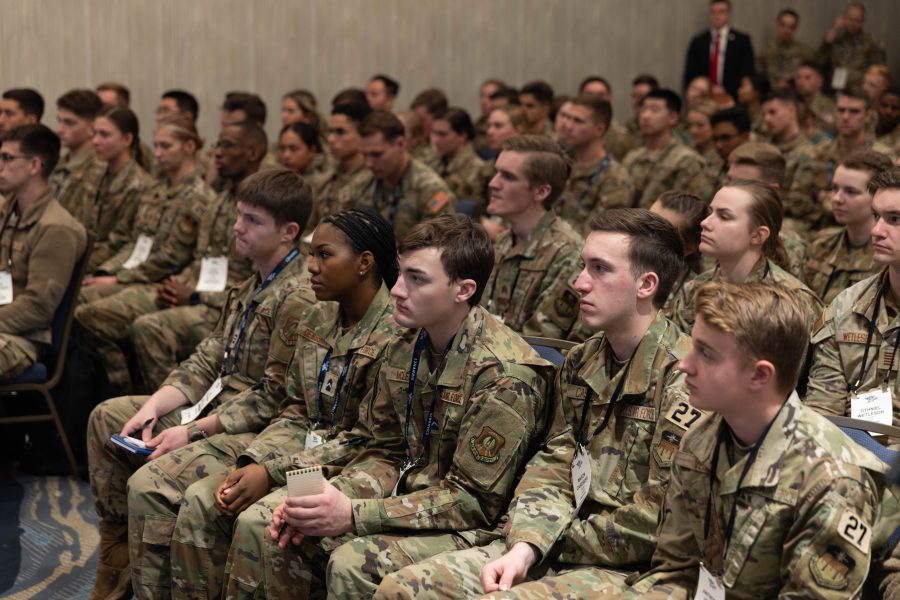At the AFA Warfare Symposium this week, the Department of the Air Force announced 24 decisions stemming from its “Re-optimization for Great Power Competition” review. Now, as the department starts the process of implementing these major changes, former Air Force Futures boss retired Lt. Gen. S. Clinton Hinote offers his perspective in this commentary.
When a successful organization faces disruptive change, it must adapt or decline. That is the choice facing our Air Force today. Others have been here and failed. Remember Kodak? Pan Am? Blockbuster? All these companies led their respective industries, but instead of adapting to disruption in their operating environment, they doubled down on existing ways of doing business. Today, they are memories.
The Air Force has been disrupted. The years of assumed air dominance are over. Our country’s focus has shifted. Key technologies have proliferated. The competition has caught up. A worthy adversary has studied our vulnerabilities and threatens to expose them. The force is not ready for this environment. If we double down on the old ways, we will decline. As Secretary Kendall made clear repeatedly this week at the AFA Warfare Symposium, “We are out of time.”
The good news is that senior leaders—including the Secretary, Air Force Chief of Staff Gen. David Allvin, and Chief of Space Operations Gen. B. Chance Saltzman—have identified what needs to change and are moving out. There are plans in place to address each of seven operational imperatives defined over the past two years. Budgets have been reworked and submitted—though Congress has been slow to enact. And now, a pivotal set of organizational reforms has been announced.
We should not underestimate the moral courage and dogged determination required to lead the force to this point. Leading change is exhausting if you do it right. These senior leaders—and the staffs that support them—have paid the price to get here.
These changes outlined this week to “re-optimize” the Air Force and Space Force for great power competition are absolutely necessary. Many come straight from extensive wargaming and analysis. The focus on preparing wings for combat is correct. The plan to reinstitute large-scale exercises, especially in the Pacific, will help these wings get ready and enhance deterrence. The stand-up of an Integrated Capabilities Command has been needed for years to give tomorrow’s Airmen what they need to win.
These are the most significant changes since the aftermath of the Cold War. The key now is implementation. This is where Gen. Allvin has nailed the theme: “Follow through.“
Looking back years from now, we will see many of these changes as milestones along a journey. The Airmen Development Command and the Integrated Capabilities Command will expand in mission to be critical catalysts for an adapting force. I believe both will eventually be led by four-star officers to reflect their critical portfolios. The re-introduction of warrant officers combined with an independent Air Forces Cyber Command may portend the eventual stand-up of a cyber service, which I believe is likely. The definition of wings as the “unit of action” along with the accompanying focus will lead to a new—and much more accurate—measurement of how much force we have vs. what is needed.
One valid concern, however, is the increase in bureaucratic complexity due to the proliferation of organizations and commands. Many new organizations are being created. Eventually, the Air Force will need to balance this by consolidating or decommissioning existing organizations. Otherwise, the service risks paralysis by diffusion of responsibility and accountability. In the past, this has stifled change by encouraging extreme tribalism, resource guarding, soft vetoes, and weak consensus. An Air Force focused on China needs a more focused organizational structure.
Congress is also focused on China, and they will likely endorse most of these changes because they don’t involve significant movements of people. But Congress may balk at standing up a new Program Assessment and Evaluation office in the Secretariat. In recent months, members of Congress have expressed concern that the Pentagon’s existing Cost Assessment and Program Evaluation (CAPE) office is hindering DOD modernization. They will likely question the need for adding an equivalent at the service level.
The main impediment to implementing change will not be Congress, however. It will be institutional resistance, driven by service members and civilians who are uncomfortable with change and allow their discomfort to descend into cynicism.
Some will employ bureaucratic resistance. They will say this is too much and too fast. They will warn against breaking the service to fix it. They will question why the dominant air force of the last 70 years must change so radically. They may even try to imply that those leading change are betraying our legacy. If you don’t believe me, look at the recent experience of the Marine Corps, where the drive to modernize the force for Indo-Pacific conflict has been met with a public revolt among retired Marine leaders.
The antidote to such resistance is consistent and near-continuous communication. Leaders at all levels must understand the “why” and the “what,” think through the “how,” and communicate clear expectations to their teams. If this happens, the Air Force can adapt to the changing environment and win the fight that looms just over the horizon. If not … well, we know how that story ends.
Lt. Gen. S. Clinton Hinote, USAF (Ret.) was Deputy Chief of Staff for Strategy, Integration, and Requirements from 2020-2023. He now serves as an advisor to the Special Competitive Studies Project, Dcode, Pallas Advisors, and the Atlantic Council’s Software-Defined Warfare Commission.


